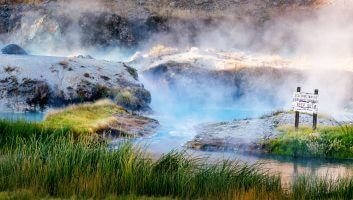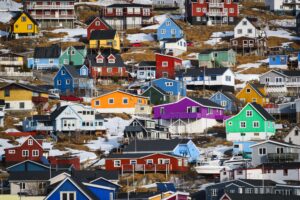Support Hidden Compass
We stand for journalism, science, history, and hope. Make a contribution to Hidden Compass and stand with us.
This story has been published in the 2023 Pathfinder Issue of Hidden Compass. While every story has a single byline, the issue is a collaborative effort. Storyteller proceeds from all patronage campaigns in this issue will go collectively to Team Tété on top of their article pay.
I file into the first of two dimly lit halls with technicolor strobes of magenta, neon green, and cerulean blue flashing across a stage and spilling onto the audience. James Ungalaq, the Canadian Inuit guitarist from the legendary First Nations band Northern Haze, steps on stage sporting a salt-and-pepper goatee. Decades ago, Ungalaq and his bandmates made history when they recorded the first Indigenous-language rock album in North America. He strums his electric guitar, classic rock notes instantly filling the hall, and the crowd erupts, roaring for several minutes before settling into the music.
During the performance, Greenlandic Inuit mask dancer Arnaq Petersen seductively weaves through the audience, puffing out her cheeks, eyes bulging, emitting sounds that rattle revelers in her path.
Even at first listen, it’s obvious this isn’t your typical rock and roll concert.
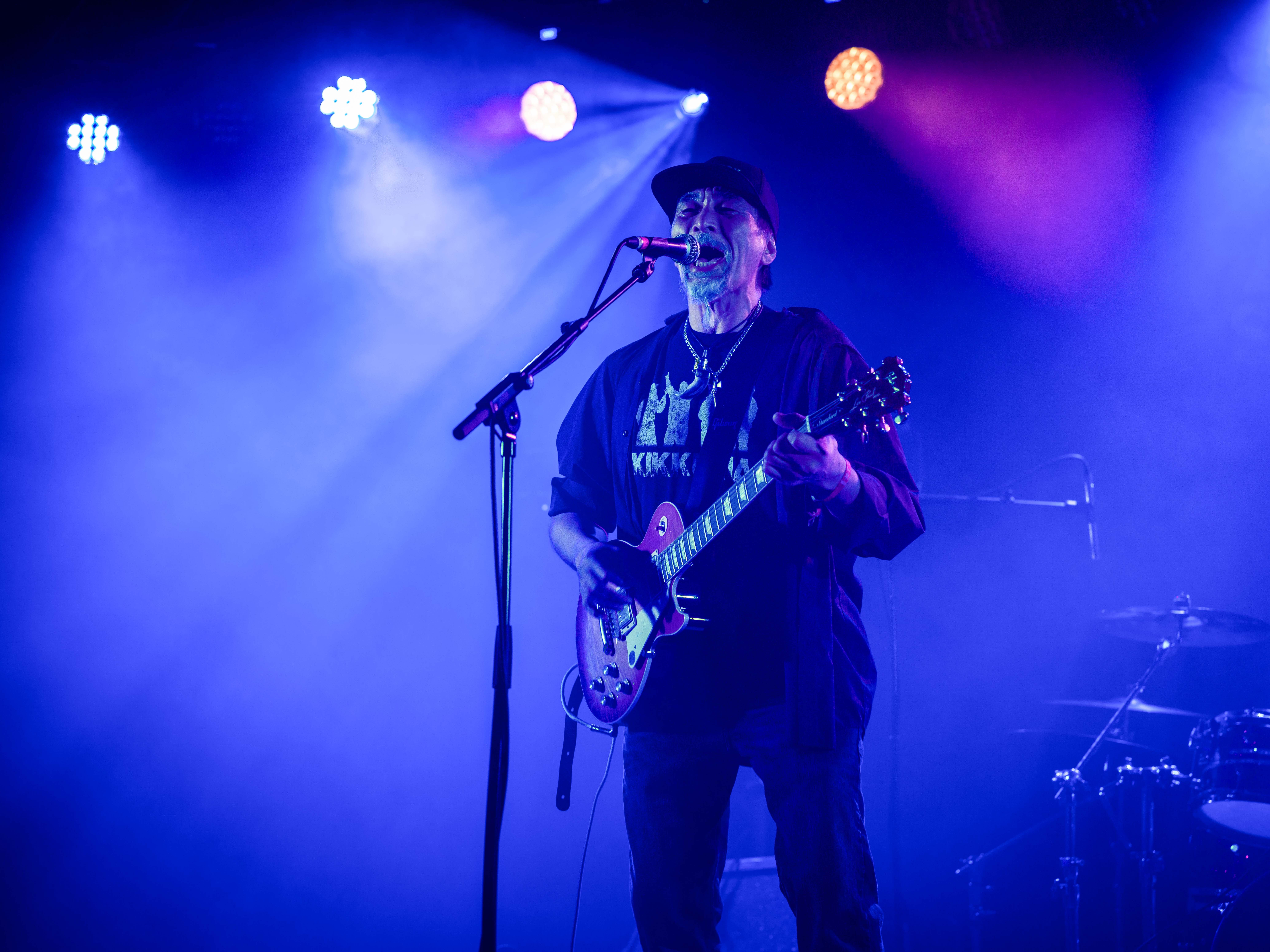
Canadian Inuit guitarist James Ungalaq, from the First Nations band Northern Haze, onstage at the Arctic Sounds Festival. Photo: Lola Akinmade Åkerström.
~~
I’ve always found Arctic and Polar regions alluring in their capacity to withstand harshness. It’s not just the ability to bear the brutal weather changes, but also to quickly recover — only to experience it all over again next winter. This toughness has echoed throughout millennia of human history in the resilience of the Inuit, who have endured colonization while remaining one of the world’s oldest Indigenous cultures.
The harshness breeds a certain grit. It’s clear once you encounter it. You only have to be willing to quiet down and listen for it.

The author is taken by the resilience and grit of those who live in harsh landscapes like those of Ilulissat, Greenland. Photo: Lola Akinmade Åkerström.
~~
Togolese explorer Tété-Michel Kpomassie once told my expedition teammates and me about a man who didn’t listen.
While Tété was living in Greenland in the 1960s, a French anthropologist around his age — both men were in their twenties — had come to spend a year doing research. Tété helped him set up camp. Decades later, the explorer chuckled when he told us the anthropologist had brought his own food — enough for the whole year. In doing so, he isolated himself from fully connecting with, and truly listening to, Greenlandic culture through one of its easiest avenues: food.
A few years later, the Frenchman would go on to publish a book as an authority on Greenlandic Inuit culture.
~~
My expedition teammates and I stare at each other in confusion after scanning the paper map we are holding. A single, large road rings the etching of the tiny town. In Sisimiut, Greenland’s second largest town, there should be no way we can get lost, even if we try.
“School of Rocks?”
We read this location out loud off the program for the Arctic Sounds Festival. Held every winter between March and April in the pint-sized town, Arctic Sounds draws performing artists from all five Nordic Countries as well as the Faroe Islands, Arctic regions, and other Indigenous communities around the world.
This isn’t your typical rock and roll concert.
School of Rocks is one of the performance venues and our current destination, but so far, we can’t find it on the map. That is, until my fingers land on the Greenland School of Minerals and Petroleum and I get the play on words. A school for future geologists. Once we realize that, we are finally on our way to the musical event, trudging through snow and shuffling along slippery roads.
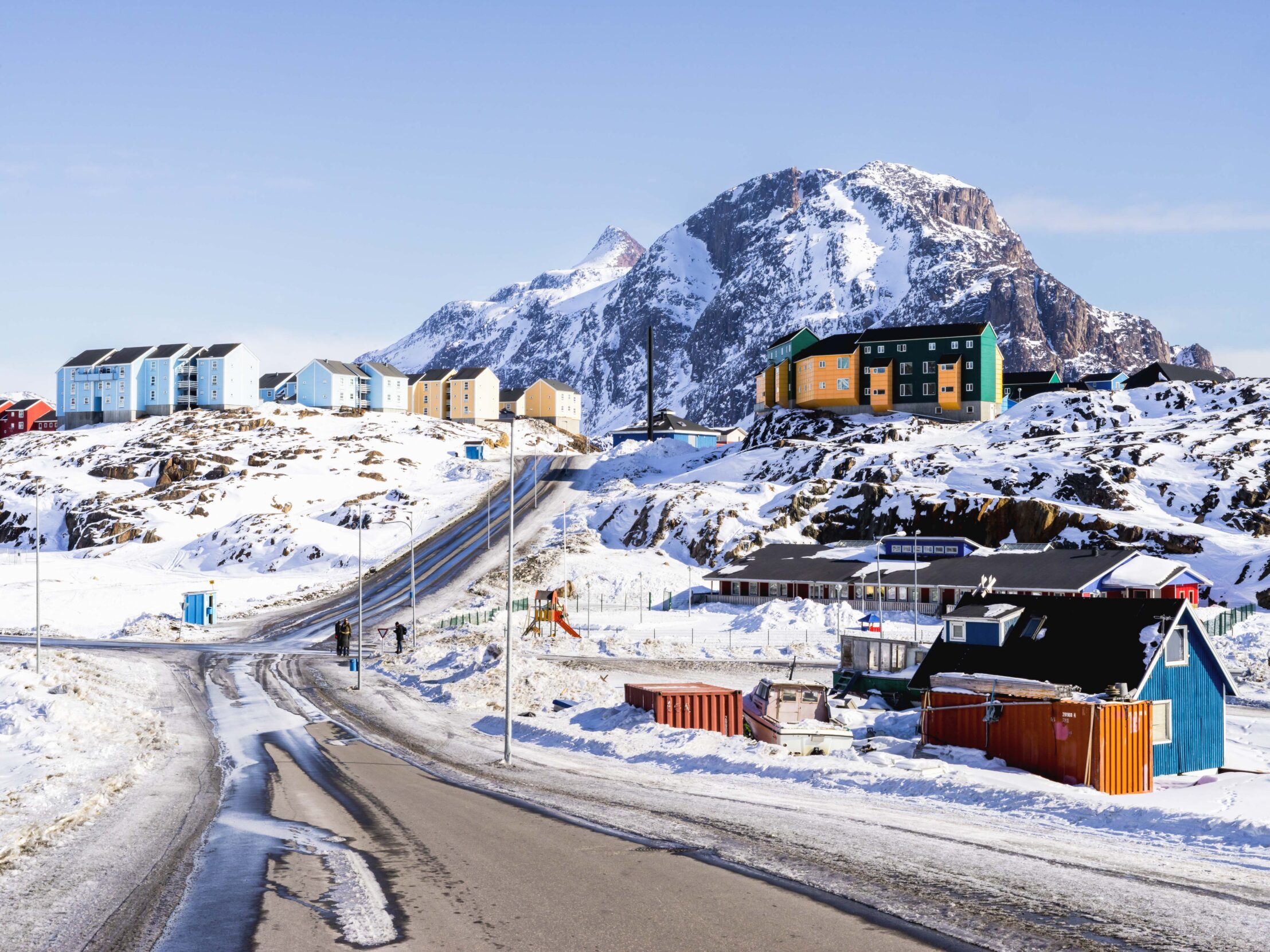
Snowy, slippery roads are common in Sisimiut, like this main road that runs through the town. Photo: Lola Akinmade Åkerström.
~~
Collectively, the Inuit are an Indigenous group with a rich cultural history spanning roughly 4,000 years and stretching across the northernmost subarctic and Arctic regions of the world, including Greenland, Canada, parts of Alaska, and Chukotka (far eastern Russia). The Inuit differentiate themselves based on dialects and regional identities. For example, West Greenlanders are Kalaallit, East Greenlanders are Iit, and those from the northern Thule district are Inugguit. In Canada, meanwhile, the main groups are Inuvialuit, Inuinnaat, and Labradormiut. While they share a common language, various dialects have developed as geographical distances separated groups for centuries.
Toughness has echoed throughout millennia of human history in the resilience of the Inuit, who have endured colonization while remaining one of the world’s oldest Indigenous cultures.
This historical backdrop is what makes the Arctic Sounds Festival so exceptional. Rocking out to both Greenlandic and Canadian Inuit artists performing together, singing songs from an album they produced in just one week, was witnessing history in the making. And I can’t help but wonder how we got here, experiencing this intimate blending of Inuit cultures.
While preparing to travel to Greenland following in Tété’s footsteps, we stumbled upon Arctic Sounds by chance. An introduction was made to Jacob Froberg, the festival’s Danish director. Much like the Frenchman in Tete’s story, we weren’t sure what to expect upon arrival in Sisimiut or why a Dane was in charge of this Indigenous-centered cultural event.
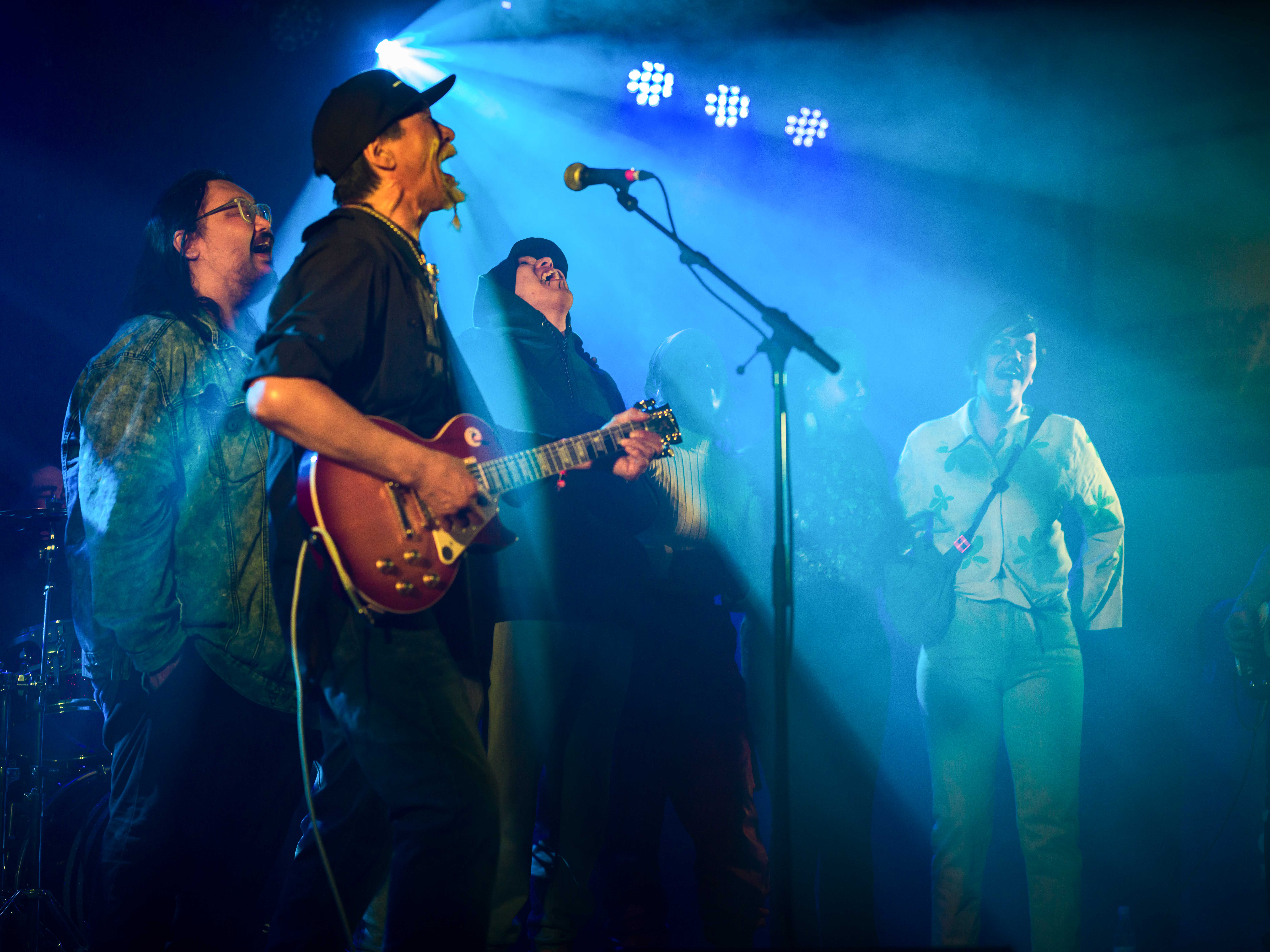
In a blending of Inuit cultures, James Ungalaq and other artists gather onstage to share their music. Photo: Lola Akinmade Åkerström.
~~
Born in Aalborg, Denmark, 49-year-old Jacob has lived in Greenland since 2006, when he relocated with his then-girlfriend to found the music school in Sisimiut. While Jacob had no ties to Greenland before moving there, his now-ex-wife had spent several years as a child in the country and worked there seasonally over the decades.
I’ve often wondered if people, like Jacob, who leave their own lands and communities to venture into someone else’s home fully listen to the lyrics of the place they’ve decided to settle in. Do they absorb the words? The anguish, pain, love, or loss, until those feelings completely intertwine with their own?
He strums his electric guitar, classic rock notes instantly filling the hall, and the crowd erupts, roaring for several minutes before settling into the music.
For years, Jacob and his wife ran an open stage event to give young musicians a chance to develop their skills. But by 2014, he felt the music scene in Sisimiut was ready to expand, and Arctic Sounds was born. The young musicians needed more opportunities to develop their songwriting and performance skills.
“We started Arctic Sounds because the local youth bands were getting better and better,” Jacob says.
Nine years after the first festival, we find ourselves at Arctic Sounds 2023. Rather than just being a place where young musicians can develop, the festival has also become a venue for cultural collaboration. This year, for the first time, songwriters and musicians from Kalaallit Nunaat (Greenland) and Nunavut in Canada collaborated on an album. The artists met in Reykjavik, Iceland, just before the festival began. Over four days, they wrote and recorded a complete album, with some additional dubbing and mixing to be done here at the festival in real time.
The project, which is the first of its kind, is called Aajuik. In the official Greenlandic language of Kalaallisut, aajuik means “something that never melts.”
“For us, it symbolizes Arctic resilience,” says Jacob.
~~
Greenlandic Inuit Jaaku Sørensen takes the stage and grabs an electric guitar. His shoulder-length walnut brown hair is pulled into a bun and he’s wearing a hoodie. He starts with a low, jazz-like riff. It’s soft, elegant, bordering on romantic.
But it’s quickly replaced by a hard, pounding pop-rock beat as he belts out the words to “Someone Peed the Pool,” a tome-like song about climate change, its deniers, and the reality of Greenlanders living its effects every day. He sings in English, and I listen, enthralled.
~~
It becomes clearer to me now: Jacob’s job is framed by listening — listening to notes, lyrics, words, emotions. It was only a matter of time before he also fell in love with the cadence and ballad of Greenland.
Perhaps this is what it truly means to fall in love with a place. To understand that the lyrics of the song can never be yours because you are not the artist, but to share how those lyrics have seeped into your soul.
A lot of privileged explorers — typically white, male, and Western, like the French anthropologist — have scoured the world, driving stakes into foreign soil, claiming a love of place and culture, and telling other people’s stories on their behalf. But I understand that through the Arctic Sounds Festival, Jacob provides a platform to bring people together to tell their own stories.
I also realize Tété-Michel had never told anyone’s story but his own.
This was why his work resonated deeply with me as a Black African woman who also happens to be part of the next generation of storytellers he inspired. I was tired of people sitting in rooms without me and crafting my narrative on my behalf.
People weren’t listening to and trying to connect with my lyrics. They were simply bobbing their heads along to the rhythm of my pain.
~~
Greenlandic Inuk rapper Tarrak takes the stage. Tattoos snake across the bridge of his nose and fan down from under his lips over his jaw. Joining him is fellow Canadian Iqaluit rapper Thomas Matthew Lambe. Together, they drop Inuit raps over reggae beats. I bounce along to the rhythm. Unlike with Jaaku, I don’t understand their words — their pain, anguish, or joy. I listen nonetheless.

Greenlandic Inuk rapper Tarrak takes the stage alongside Canadian Iqaluit rapper Thomas Matthew Lambe. Photo: Lola Akinmade Åkerström.
~~
Aajuik. As I spent time at the festival, the name of the project, symbolizing resilience, seemed more than fitting. For me, it encompasses the resolve to keep belting your tune over the centuries, regardless of whether or not people choose to listen.
I was expecting carefree revelers at Arctic Sounds. What I walked into instead was a space for listening to and witnessing what cultural evolution feels like. A space where rappers lay their Kalaallisut lyrics over Jamaican reggae beats, and Indigenous performers strum electric guitars and sing in English about climate change.
Perhaps this is what it truly means to fall in love … to understand that the lyrics of the song can never be yours because you are not the artist, but to share how those lyrics have seeped into your soul.
The first batch of songs from Aajuik were released in June as a four-song EP by Nunavut-based label Aakuluk Music. The remaining songs dropped earlier this month, and a vinyl edition is planned as well. “It’s the first time a collaboration between musicians from Kalaallit Nunaat and Nunavut has been done at this level,” Jacob says. “We see it as an important step towards strengthening the cultural ties across the Inuit region at a professional level.”
Jacob will continue this tight cultural integration in 2024 as Arctic Sounds celebrates its 10th anniversary. They’re aiming for concerts on two glaciers in collaboration with global grassroots organization In Place of War. And the next co-creative project will be written during a five-day dog sledding expedition.
“They will start in Kangerlussuaq, and on the last day of the journey they will literally walk from the dog sleds and on to the stage at Arctic Sounds to play the material they have written during the trip,” Jacob shares with excitement.
Who knows if those songs created together in the vast Arctic tundra will eventually become global chart toppers. But to witness them being made and sung with love and reverence, rooted in centuries-old cultures that are still evolving, morphing, and fusing with other global influences, is nothing short of a privilege.
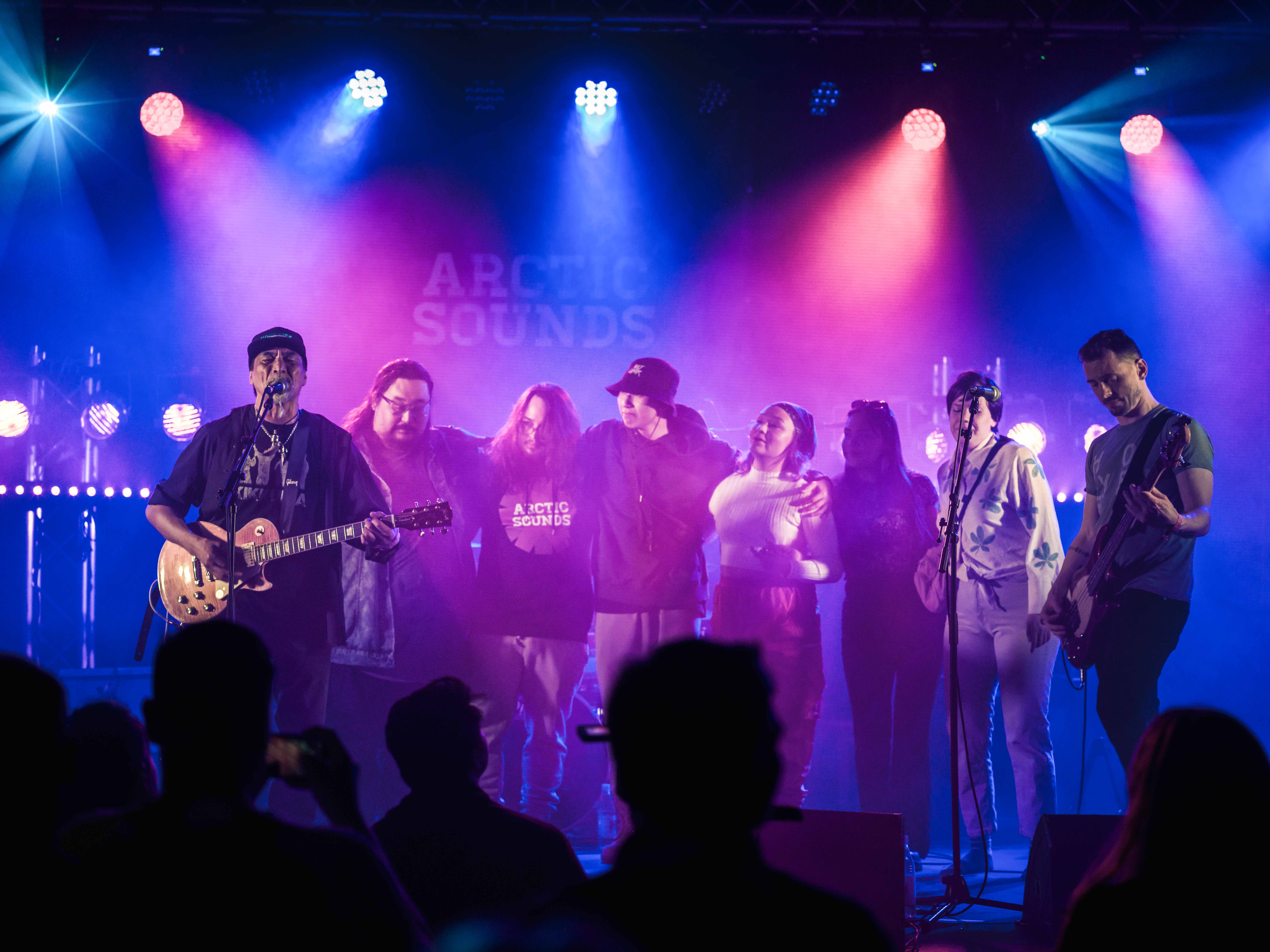
Ungalaq and Tarrak join other artists onstage at the Arctic Sounds Festival, which celebrates its 10th year in 2024. Lola Akinmade Åkerström.
~~
Inside the venue, music pulses, but outside, the silence is unnerving. A loud reminder of just how far away from home we are.
Earlier that evening, the festival had opened up to ethereal choruses floating in the dark night at Taseralik cultural center — a beautiful and haunting sound that surely drifted on the shores of Lake Nalunnguarfiup Tasia and in the shadow of Mount Nasaasaaq.
Who gets to tell the story of a place? In my search for answers, I have given space to anyone who has fallen in love with that place — anyone who has quieted enough to hear the music and intertwine their lives with the lyrics of its people.
Lola Akinmade Åkerström
Lola Akinmade Åkerström is the 2023 Pathfinder Prize-winning expedition leader and cinematic art director for “In Tété’s Footsteps: A Cultural Expedition in Greenland.”
Never miss a story
Subscribe for new issue alerts.
By submitting this form, you consent to receive updates from Hidden Compass regarding new issues and other ongoing promotions such as workshop opportunities. Please refer to our Privacy Policy for more information.

